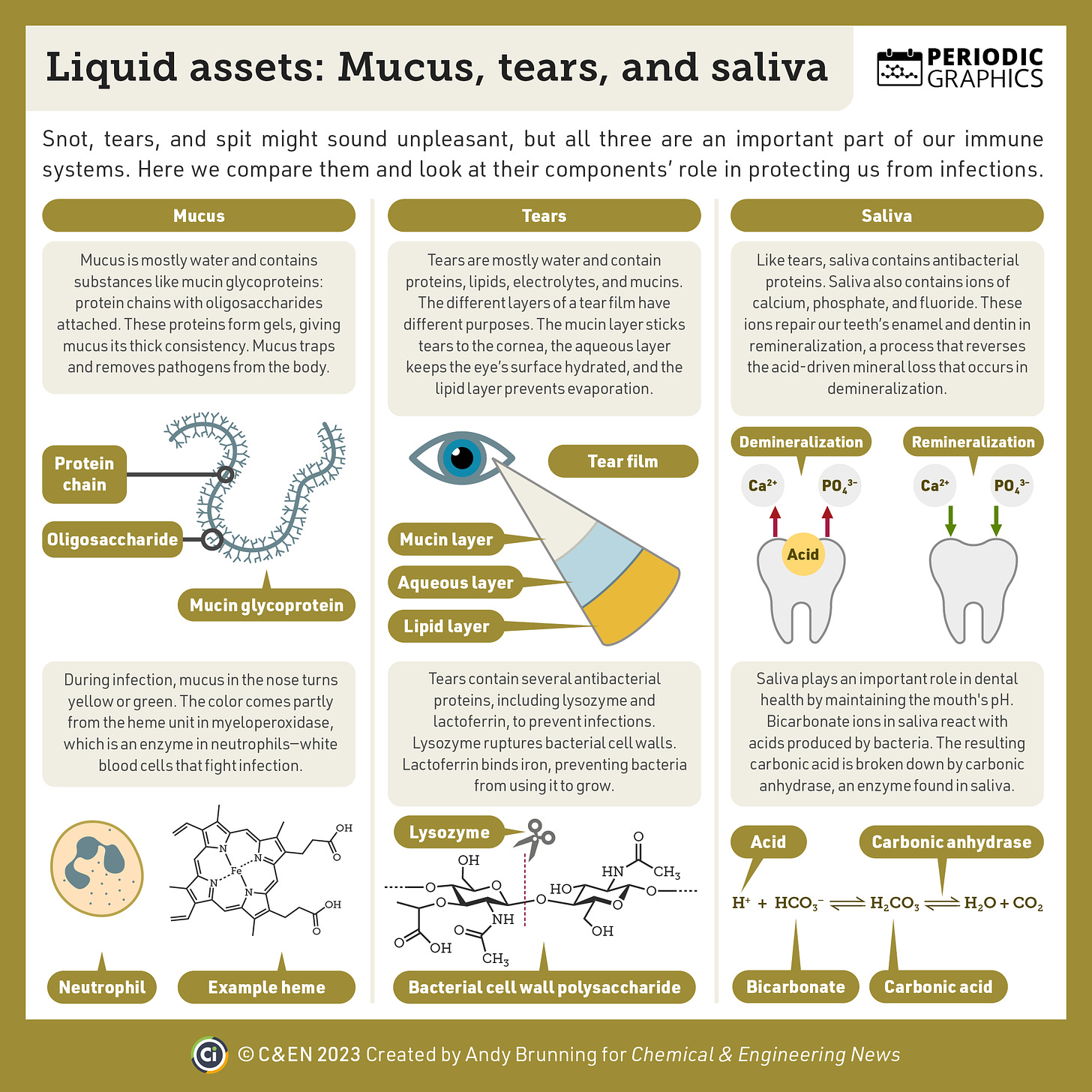Periodycal #8: IWD, and why is snot yellow?
More women from chemistry history, snotty enzymes, and more
Welcome to another edition of Periodycal! In this issue, we focus on women in chemistry for International Women’s Day. There’s also a look at the biochemistry behind snot, spit and tears in the latest edition of Periodic Graphics. There’s also the usual look ahead to upcoming events and relevant past graphics, as well as selected chemistry news and features.
International Women’s Day
Today is International Women’s Day, and it’s become a yearly thing for me to put together an additional graphic in the Women in Chemistry History series. This year’s features women who’ve made important contributions to rare earth element separation, vaccine development, and more.
It also includes Irma Goldberg, who has the distinction of being one of the few women who has an organic reaction unambiguously named after her. There’s an interesting paper here which looks at the history of women associated with named reactions, which also includes Elizabeth Hardy, featured in the graphic. It’s clear that named reactions seem to embed the historical biases against women and other historically underrepresented groups in organic chemistry. Should chemistry be looking to move away from these named reactions in the interests of inclusivity?
If you missed the previous editions of this series, they’re all available at the links below: Part 1 | Part 2 | Part 3 | Part 4
There’s also the series of cards I did on contemporary women in chemistry which are available here.
Snot, spit and tears
Spit, snot and tears — might sound a bit gross, but they’re one of the first-line defences of our bodies’ immune systems. The latest edition of Periodic Graphics in C&EN looks at how they protect us from infection.
This one was a tricky one to put together, particularly when it came to identifying the particular components that make snot yellow, which was the discussion which launched this graphic in the first place. I eventually homed in on myeloperoxidase as a key component, a green enzyme that’s present in some of the white blood cells that fight infection. Its common description as being green rather than yellow still leaves me feeling that there are additional, unidentified components at play, though. If anyone reading this has additional knowledge, please let me know!
Upcoming chemistry tie-ins
Here’s a quick run-down of upcoming events or days and links to some relevant chemistry graphics from the archives:
9 March: National No Smoking Day — Chemicals in cigarette smoke
13 March: National Jewel Day — What causes the colour of gemstones?
17 March: St Patrick’s Day — The chemistry of Guinness
18 March: Global Recycling Day — How is plastic recycled?
20 March: National Proposal Day — Wedding ring metal properties
20 March: National Frog Day — The chemistry of poisonous frogs
Chemistry news and features
Here’s the regular round-up of chemistry news and features I’ve found interesting over the past couple of weeks:
Complex organic compounds found in interstellar space — Researchers found complex organic compounds, similar to those seen in coal and oil, in dust formed by exploding stars.
Chemistry course corrections tackle bias — An interesting account of how the University of York set about decolonising its chemistry curriculum.
As always, let me know if you’ve any suggestions for the newsletter, or for future graphics.
Thanks for reading,
Andy







Quick update – someone has kindly pointed out that Irma Goldberg is not, in fact, the only woman to have an organic reaction unambiguously named after her, so I've corrected the text here accordingly.
There's the Catellani reaction, discovered by Marta Catellani: https://en.wikipedia.org/wiki/Catellani_reaction
There's also the Staudinger-Bertozzi ligation, partly named for Nobel Prize-winning chemist Carolyn Bertozzi.
And if you do a graphic on the forever chemicals, I think it would be very relevant with the chemical spill concerns in Ohio, etc. plus the food chain issues with humans catching and eating fresh water fish. We have a well, so I always wonder about that. We filter our water and buy the filters/pitchers from Clearly Filtered. But that company sends me information on water safety and educational stuff. I bet they would like your graphics also. Or make one that would work for their needs and they might buy it from you for their use!! Thanks for what you are doing.